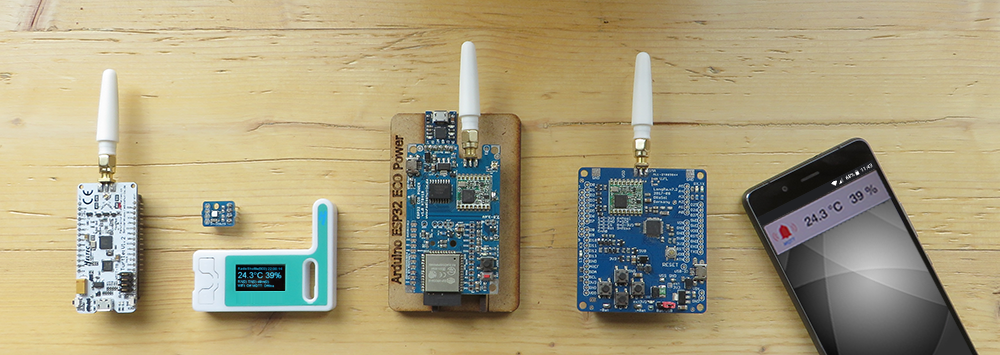Do I also need an Arduino for the ECO Power board?
No, the ECO Power board has an Arduino compatible ESP32 built-in and can be used directly with the Arduino program. The Technical Documentation describes which pins may already be assigned by LoRa, buttons, etc.
Can the ECO Power board also use WiFi?
Yes, the ESP32 module used has integrated WiFi functionality. Standard ESP32-Arduino WiFi sample programs will run. Please note that WiFi requires a lot of power and should be switched off completely after use.
Can the ECO Power board also use Bluetooth?
Yes, the ESP32 module used has Bluetooth functionality. For information on the Bluetooth APIs, see the Espressif and Arduino documentation.
What is the difference to the “ESP32 Dev Module”?
The ECO Power board uses the identical ESP32-WROOM-32 module from Espressif and is identical in many areas. However, SPI and other GPIO pins are already used for LoRa radio technology, I2C is also active and is used with the additional clock (RTC) and the external temperature and humidity sensor. The USB interface is implemented via an external programming adapter, a reset via USB is not possible. The ECO Power board has a separate power supply with automatic switchover for battery operation, enabling battery operation for years.
How can I use the U.FL or SMA antenna connector?
On the lower right there are very fine solder bridges, which connect the antenna output between the antenna wire (standard), U.FL or SMA. Only one bridge may be set at a time. Further information can be found in the Technical Documentation section.
What is the maximum voltage for the Arduino pins ?
The external input voltage must not exceed 3.6 volts. The output voltage of the pins depends on the power supply and/or the battery condition and can be 2.5 to 3.6 volts, usually approx. 3 volts.
Can the power supply for external sensors be completely switched off?
The internal operating voltage (2.5-3.6 volts) can be switched by software via the “VDD-SW” pin in the middle of the board (first pin seen from below). This is switched off by default so that external consumers, such as battery measurement or advanced RTC functions, do not consume permanent power. The “VDD-SW” pin can also be used to connect other loads such as sensors, for which the current is only switched on briefly when required.
What does the ID on the back mean?
The ID is a unique node number (device ID) which each device must have to communicate with the RadioShuttle protocol.
Can I set any ID (device ID) per board myself?
No, you have to use the ID and the code on the back, otherwise it won’t work. Of course, when sending a message, the device ID of the target device can be set as desired.
Can the ECO Power board also be operated with AAA batteries?
Yes, with two Lithium(!) AAA batteries, see detailed information: Operation with AA/AAA batteries. If an external battery compartment is used, make sure that the cable from the battery to the board is as short as possible.
Can NiMH rechargeable batteries be used?
Commercially available NiMH batteries cannot be used because one cell delivers 1.2 volts. With two cells the required minimum voltage of 2.5 V is not reached. Using three NiMH cells would exceed the maximum permitted voltage.
Is operation via a USB power bank possible?
A USB power supply is supported and works perfectly, simply connect it via micro-USB. There are two problems to consider with a power bank: In “deepsleep” mode, the ECO Power board requires so little power that various power banks switch off automatically on a regular basis, as they believe that no consumers are connected.
In addition, operation with a power bank is not energy-efficient, as the power bank internally converts the LiPo battery voltage from 3.7 V to 5.0 V, the ECO Power board then converts the 5.0 V back to approx. 3.3 V. These two conversions are permanent and consume energy.
Can I switch 230 V loads with the ECO Power board?
So-called external “solid-state” relays can switch 230 V loads with a 5 V input voltage. The Arduino ports can control several external solid-state relays (SSR) via a simple transistor circuit.
What is the maximum allowed battery input voltage?
The battery connector input voltage can range from 2.5 to 3.6 volts. More than 3.6 V is not allowed and will lead to hardware damage.
Can the battery voltage be measured?
Yes, the battery voltage is automatically measured when starting. The “RTCUtil.cpp” file includes the GetBatteryVoltage() function which delivers the battery voltage.
